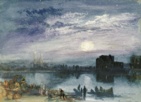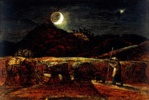

Paintings by members of the French Romantic school
include those by Théodore Géricault (French, 1791-1824)
and Eugène Delacroix (French, 1798-1863), filled with rich
color, energetic brushwork,
and dramatic and emotive subject
matter. In England the Romantic tradition began with Henry Fuseli
(Swiss-English, 1741-1825) and William Blake (1757-1827), and
culminated with Joseph M. W. Turner (1775-1851) and John Constable
(1776-1837). The German landscape painter Caspar David Friedrich
(1774-1840) produced images
of solitary figures
placed in lonely settings amidst ruins, cemetaries, frozen, watery,
or rocky wastes. And in Spain, Francisco Goya (1746-1828) depicted the horrors of war
along with aristocratic portraits.
Examples of works of this period are:
Listing
chronologically by artist's birth year
Use ctrl-F (PC) or command-F (Mac) to search for a name
Sir Joshua Reynolds (English, 1723-1792), General John Burgoyne, c. 1766, oil on canvas, 50 x 39 7/8 inches (127 x 101.3 cm), Frick Collection, NY.

Philip James De Loutherbourg (English, 1740-1812),
The Battle of the Nile, 1800, oil
on canvas, 152.4 x 214.0
cm, Tate Gallery, London.

Philip James De Loutherbourg, An
Avalanche in the Alps, 1803, oil
on canvas, 109.9 x 160.0
cm, Tate Gallery, London. See nocturne.

Henry Fuseli (born Johann Heinrich Füssli)
(English, born Switzerland, 1741-1825), Percival Delivering Belisane from the Enchantment
of Urma, 1783, oil
on canvas, 99.1 x 125.7
cm, Tate Gallery, London. In his native Switzerland, Fuseli studied
to be a priest, and then came to London in the 1760s to study
writers of 'genius', such as Shakespeare and Milton. In London
he decided to become a painter and gained fame for the nightmarish
intensity of his images, which often show characters overtaken
by madness. See self-portrait.
Henry Fuseli, Titania, Bottom and the Fairies, painting. In a scene from Shakespeare's A Midsummer Night's Dream, Bottom, the fellow with the enlarged ears, has temporarily been turned into a donkey. Tatiana, the Queen of the Fairies, has been moved by a magic spell to fall in love with him.

Henry Fuseli, Titania and Bottom, c. 1790, oil
on canvas, 217.2 x 275.6
cm, Tate Gallery, London.

Henry Fuseli, The Shepherd's Dream, from 'Paradise Lost',
1793, oil on canvas,
154.3 x 215.3 cm, Tate Gallery, London.

Henry Fuseli, The Night-Hag Visiting Lapland Witches,
1796, oil on canvas,
40 x 49 3/4 inches (101.6 x 126.4 cm), Metropolitan Museum of
Art, NY. Born in Switzerland, of Swiss and German parents, Fuseli
migrated to Berlin in 1763, where his illustrations of Shakespearean
themes caught the attention of the British ambassador, who convinced
him to visit England. Several years later he moved to Rome. By
1779 he had returned to England, and the best of his paintings
were completed in London.

Henry Fuseli, Lady Macbeth Seizing the Daggers, 1812,
oil on canvas,
101.6 x 127.0 cm, Tate Gallery, London.

Francisco José de Goya y Lucientes
(Spanish, 1746-1828), Condesa de Altamira and Her Daughter, Maria Agustina,
1787-1788, oil on canvas,
76 7/8 x 45 1/4 inches (195 x 115 cm), Metropolitan Museum of
Art, NY.

Francisco José de Goya y Lucientes,
Don Manuel Osorio Manrique de Zuñiga (1784-1792),
possibly 1790s, oil on
canvas, 50 x 40 inches
(127 x 101.6 cm), Metropolitan Museum of Art, NY. (On the Met's
page, you can enlarge any detail.)

Francisco
de Goya y Lucientes, Saturn Devouring one of his Sons, mural transferred to canvas,
(146 x 83 cm), Prado Museum, Madrid. See grotesque
and mythology.

Francisco José de Goya y Lucientes,
Giant, by 1818, XIX, burnished
aquatint, first
state; sheet: 11 1/4 x
8 1/4 inches (28.5 x 21.01cm), Metropolitan Museum of Art, NY.

Francisco José de Goya y Lucientes, The Forge, between c. 1815 and 1820, oil on canvas, 71 1/2 x 49
1/4 inches (181.6 x 125.1 cm), Frick Collection, NY.

William Blake (English, 1757-1827), Pity, c. 1795, color print finished in
ink and watercolor on paper,
42.5 x 53.9 cm, Tate Gallery, London. The subject is partly drawn
from Shakespeare's play Macbeth. See illustration.

William Blake, Elohim Creating Adam, 1795 / c. 1805,
color print finished in ink and
watercolor
on paper, 43.1 x 53.6 cm, Tate
Gallery, London.

William Blake, Newton, 1795 / c. 1805, color print finished
in ink and watercolor on paper,
46.0 x 60.0 cm, Tate Gallery, London.

Caspar David Friedrich (German, 1774-1840),
On Board a Sailing Ship, 1818-1820, oil on canvas,
28 x 22 inches (71 x 56 cm), Hermitage Museum, St. Petersburg,
Russia.

Caspar David Friedrich, The Solitary Tree, 1822, oil
on canvas, 55 x 71 cm,
Nationalgalerie, Berlin. A lone shepherd leans against the trunk
of this ancient tree, watching his flock of sheep.
![]()
Caspar David Friedrich, Woman at a Window, 1822, Nationalgalerie,
Berlin. A lone woman stands gazing out an upper-storey window.
We see the top of a sailboat's rigging against the sky.
Caspar David Friedrich, Moonrise, 1835-1837, sepia wash over a pencil sketch, bordered with India ink, 24.5 x 34.5 cm, Hermitage Museum, St. Petersburg, Russia.

Joseph Mallord William Turner (English, 1775-1851), Moonlight, a Study at Millbank, 1797, oil on canvas, Tate Museum, London. See English art and nocturne.

Joseph Mallord William Turner,
Conway Castle, North Wales, 1798, watercolor and gum
arabic with graphite
underdrawing, 21 1/8 inches
x 30 1/8 inches (53.6 x 76.7 cm), J. Paul Getty Museum, Malibu,
CA.

Joseph Mallord William Turner, Cologne: The Arrival of a Packet-Boat: Evening, 1826, oil and possibly watercolor on canvas, 66 3/8 x 88 1/4 inches (168.6 x 224.1 cm), Frick Collection, NY.

Joseph Mallord William Turner, The Harbor of Dieppe, 1826?, oil on canvas, 68 3/8 x 88 3/4 inches (173.7 x 225.4 cm), Frick Collection, NY.

Joseph Mallord William Turner, Saint Denis, c. 1833, oil on canvas, Tate Museum, London. See nocturne.

Joseph Mallord William Turner, The Grand Canal, Venice, c. 1835, oil on canvas,
36 x 48 1/8 inches (91.4 x 122.2 cm), Metropolitan Museum of
Art, NY. (On the Met's page, you can enlarge any detail.)

Joseph Mallord William Turner, The Lake of Zug, 1843, watercolor with gouache and colored chalks, over traces of graphite;
extensive scraping with penknife, 11 3/4 x 18 3/8 inches (29.8
x 46.6 cm), Metropolitan Museum of Art, NY.

John Constable (English, 1776-1837), Salisbury Cathedral from the Bishop's Grounds,
c. 1825, oil on canvas,
34 5/8 x 44 inches (87.9 x 111.8 cm), Metropolitan Museum of
Art, NY. (On the Met's page, you can enlarge any detail.)
Théodore Géricault (French, 1791-1824), The Raft of the Medusa, 1819, oil on canvas, 4.91 x 7.16 m, Louvre. Géricault pictures a real-life drama of 149 shipwrecked sailors from the frigate "Medusa", abandoned for twelve days on a raft off the Senegalese coast. He chose to depict the moment on July 17, 1816 when the 15 survivors were overcome with despair as the "Argus", the ship that eventually was to rescue them, sailed off.

Francis Danby (English, 1793-1861), Romantic Woodland, c. 1824-5, watercolor, gum
arabic and pencil
on paper, 19.4 x 26.0 cm, Tate
Gallery, London.

Francis Danby (British, 1793-1861), The Deluge, exhibited 1840, oil
on canvas, 284.5 x 452.1
cm, Tate Gallery, London.

Jean-Baptiste-Camille Corot (French, 1796-1875),
The
Lake, 1861, oil
on canvas, 52 3/8 x 62
inches (133 x 157.5 cm), Frick Collection, NY.

Carl Blechen (German, 1798-1840), The
Interior of the Palm House, 1832, oil
on paper,
mounted on canvas, 64 x
56 cm, Nationalgalerie, Berlin.

Ferdinand-Victor-Eugène Delacroix
(French, 1798-1863),
Saada, the Wife of Abraham Benchimol, and Préciada,
One of Their Daughters, 1832, watercolor
over graphite, 8 3/4 x
6 3/8 inches (22.2 x 16.2 cm), Metropolitan Museum of Art, NY.
Ferdinand-Victor-Eugène Delacroix, Strolling Players, 1833, watercolor, 9 3/4 x 7 1/4 inches (24.8 x 18.4 cm), Los Angeles County Museum of Art.

Ferdinand-Victor-Eugène Delacroix, Fanatics of Tangier, 1837-1838, oil
on canvas, 38 1/2 x 51
1/2 inches, Minneapolis Institute of Arts. See Orientalism.

Ferdinand-Victor-Eugène Delacroix,
The Abduction of Rebecca, 1846, oil
on canvas, 39 1/2 x 32
1/4 inches (100.3 x 81.9 cm), Metropolitan Museum of Art, NY.
(On the Met's page, you can enlarge any detail.)

Ferdinand-Victor-Eugène Delacroix,
Lion Hunt in Morocco, 1854, oil
on canvas, 74 x 92 cm,
Hermitage Museum, St. Petersburg, Russia.

Attributed to Ferdinand-Victor-Eugène
Delacroix, Lion Devouring a Goat, mid 19th century,
oil on canvas,
17 x 27 inches, Minneapolis Institute of Arts. See animalia.

Samuel Palmer (English, 1805-1881), A Hilly Scene, c. 1826-8, watercolor
and gum arabic on paper on mahogany, 206 x 13.7 cm,
Tate Gallery, London.

Samuel Palmer, A Cornfield by Moonlight with the Evening Star, c. 1830, watercolor with body color and pen and ink, British Museum, London.

Samuel Palmer, A Dream in the Apennine, exhibited 1864,
watercolor and gouache on paper
laid on wood, 66.0 x 101.6 cm,
Tate Gallery, London.

Jean-Jacques Feuchère (French, 1807-1852), Satan, c. 1836, , bronze,
height 31 inches (78.7 cm),
Los Angeles County Museum of Art.

Andreas Achenbach (German, 1815-1910), Sunset after a Storm on the Coast of Sicily,
1853, oil on canvas,
32 3/4 x 42 1/4 inches (83.2 x 107.3 cm), Metropolitan Museum
of Art, NY.

George Inness (American, 1825-1894), Spring Blossoms, Montclair, New Jersey,
1891?, oil and crayon
or charcoal on canvas,
29 x 45 1/4 inches (73.7 x 114.9 cm), Metropolitan Museum of
Art, NY.
Frederic Edwin Church (American, 1826-1900), The Icebergs, 1861, oil on canvas, 64 1/2 x 112 1/2 inches (163.8 x 285.8 cm), Dallas Museum of Art. See Hudson River School and Luminism.

Arnold Böcklin (Swiss, 1827-1901), The
Island of the Dead, 1883, oil
on wood panel,
80 x 150 cm, Nationalgalerie, Berlin. See Symbolism.
![]()
Also see isms and -ism, sentiment, and universal artwork.
https://inform.quest/_art